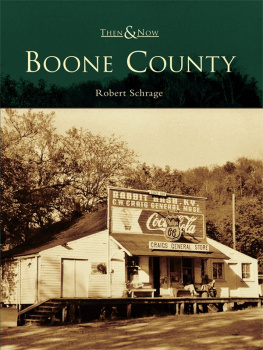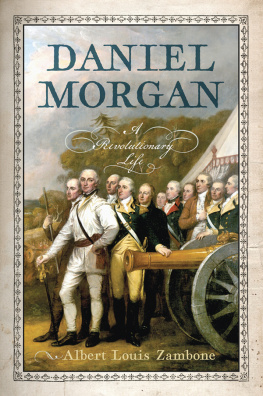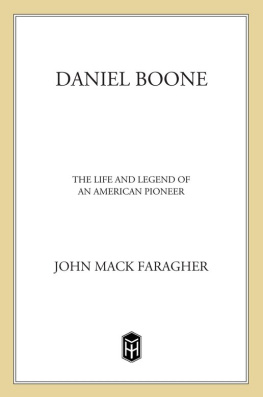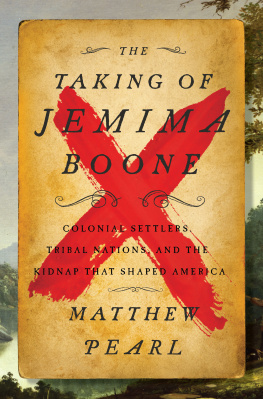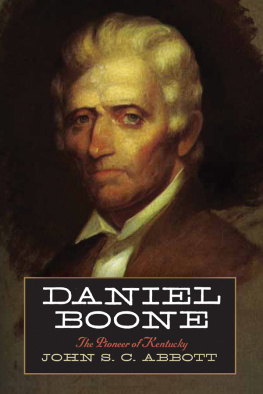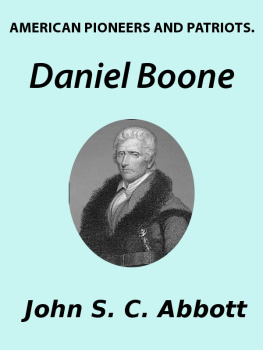Acknowledgments
FIRST I MUST express my indebtedness to my friends in Kentucky. Neal O. Hammon served as guide at many sites, including Boonesborough, Bryans Station, Boones Station, and Big Bone Lick. From the beginning he shared both his erudition and his considerable collection of documents about Boone and the history of Kentucky. Richard Taylor lent me books from his personal library, gave me a tour of historic Frankfort, and provided me with hours of informative conversation. It was Richard who started me thinking of writing about Boone on a tour of the Kentucky River almost thirty years ago. Nancy OMalley also gave me the benefit of her expertise in conversations at such sites as Boones Station, Marble Creek, Brushy Creek, and Maysville. Julian Campbell helped fill in some of the gaps in my knowledge of the historical ecology of the Bluegrass region. George Brosi offered advice and encouragement at a crucial time. Jonathan Greene and Dobree Adams always welcomed me to Frankfort and Riverbend Farm and provided introductions to Kentucky history and historians.
My friend Loyal Jones of Berea introduced me to several themes in Kentucky history and pointed me in the direction I would need to go. Jay Buckner and Tim Jordan of Berea College Public Relations Office provided me with a copy of the Boone portrait in the Boone Tavern. Bill Cooke of the Kentucky Horse Park informed me of the prevalence of the quarter horse in early Kentucky history, and Dr. Phil Sponenburg explained the importance of Spanish and Indian horses in the period of settlement.
Kathryn Weiss shared her passion and scholarship about the Bryan family history with me and prevented me from making a number of mistakes about Rebecca Boones ancestors. Ken Kamper of the Boone Society guided me through Nathans house on Femme Osage Creek and gave me a wealth of information about Boones life in Missouri.
I have been especially fortunate in the help I have received from archivists and librarians. Robert Anthony and his staff at the North Carolina Collection of the Wilson Library at the University of North Carolina at Chapel Hill from the beginning of this project found relevant documents, opened the Henderson Papers for my inspection, and provided copies whenever I needed them. William Marshall of the University of Kentucky library archives came to my rescue when I was looking for a particular letter, as did Vaughn Stanley and Lisa McCown of the Leyburn Library at Washington and Lee University. James J. Holmberg and his staff at the Filson Historical Society welcomed me to their collection and found the files I needed to consult. Mary Winters, Lynn Hollingsworth, Bill Morris, and Jim Kastner of the Kentucky Historical Society in Frankfort again and again offered me their help in locating documents in the Boone Family biographical files. The staff of the Kentucky State Archives in Frankfort found files of the Kentucky Gazette for me to explore. Mrs. Jane Brown of the Montgomery County Museum in Christiansburg, Virginia, provided a copy of the original arrest warrant for Daniel Boone issued there. The staff of the Wilderness Road Museum in Newbern, Virginia, gave me a tour of their historic buildings and provided much information about that section of the Great Wagon Road.
At Cornell University Peter Hirtle of Olin Library ordered a copy of the Spraker Boone Family Genealogy for my use. Robin Messing and the staff of the microfilm library again and again came to my rescue as I inched my way through films of the Draper Manuscripts. The staff of the Kroch Rare Books Room found volume after volume I needed to consult. The Olin Interlibrary Loan staff borrowed books and microfilms many times for my use. I would like to especially thank Sarah Thomas, former Cornell University librarian, for helping to make so many materials available to me, and Nicole Margirier for locating an elusive illustration.
I also owe a debt of gratitude to the staff of the Missouri Historical Society in St. Louis and to my daughter Laurel and her husband, Kevin Riebs, for showing me around the Boone sites in St. Charles County, Missouri. Daniel Meyer, Julia Gardner, and the staff of Special Collections of the Regenstein Library at the University of Chicago were unstintingly gracious and helpful in guiding me through the Durrett Collection there. I have also greatly benefited from the services of the Furman University library, the Duke University library, and the East Carolina University library. I would also like to thank Larry Odzack and the staff of the North Carolina State Archives in Raleigh for helping me locate court records from colonial Rowan County.
Many individuals have been of special help in providing information and encouragement throughout this project: Joseph Flora, my first professor of English at UNCChapel Hill; Cece Conway of Appalachian State University; John and Suzanne Canfield of Winnetka, Illinois; Park Lochlair; Pat and Resa Bizarro; Josh Beckworth at Appalachian State University; former chancellor Frank Borkowski of Appalachian State University; Sandra Ballard of Appalachian State University; and Tense Banks of Linville Falls. Randell Jones, author of In the Footsteps of Daniel Boone, provided much crucial information and enthusiasm for this biography. Ted Franklin Belue gave me the benefit of his considerable scholarship concerning Kentucky and Native American cultures.
At Cornell University my colleagues Jonathan Culler, Molly Hite, Marianne Marsh, and Laura Brown provided travel funds that enabled me to visit a number of archives and historical sites. Robin Doxtater helped sort out those accounts as well as my eccentric recordkeeping.
The staff at the Boone Birthplace in Oley, Pennsylvania, shared their expertise on a cold rainy day in October. I would also like to thank those who have generously read portions or all of the manuscript and helped me correct many mistakes: Neal O. Hammon, Nancy OMalley, Ted Franklin Belue, and Stephen Aron. Any mistakes remaining are, of course, my own responsibility. Ted Arnold of the Cornell Store again and again located and acquired the books I needed, both old and new.
I owe a great debt to my agent, Liz Darhansoff, for encouraging and making this project possible, to my outstanding editor Shannon Ravenel for guiding me through the long process of writing and editing, and Elisabeth Scharlatt and her staff at Algonquin Books of Chapel Hill for ensuring that this study of Boone would reach the reading public. I would like to thank Anne Winslow for her memorable work as a designer, and Brunson Hoole, managing editor of Algonquin Books of Chapel Hill, for an exemplary job of coordinating all the editorial efforts involved in the project. I am fortunate indeed to have been led through the editorial maze by Jude Grant.
My son, Benjamin, generously provided digital copies of several illustrations and photographed the Squire and Sarah Boone tombstone in Mocksville, North Carolina. I owe much gratitude to my wife, Nancy, for her sharp editorial eye, advice, and patience throughout a long and challenging project.
Bibliography
Abbott, John S. C. Daniel Boone, Pioneer of Kentucky. New York: Dodd & Mead, 1872.
Alderman, Pat. The Overmountain Men. Johnson City, TN: The Over-mountain Press, 1986.
Alford, Thomas Wildcat. Civilization. Norman: University of Oklahoma Press, 1936.
. Shawnee Domestic and Tribal Life. In Old Chillecothe, edited by W. A. Galloway, 170206. Xenia, OH: The Buckeye Press, 1936.
Alvey, R. Gerald. Kentucky Bluegrass Country. Jackson: University Press of Mississippi, 1992.
Alvord, Clarence Walworth Daniel Boone. American Mercury, June 8, 1926, 22670.
. The Daniel Boone Myth. Journal of the Illinois State Historical Society



